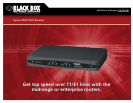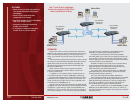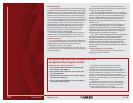
3 of 4
9/5/2007
#11749
724-746-5500 blackbox.com
Available models
The affordable 2-port midrange T1 or 4-port E1 midrange
standalone models are ideal for branch offices and are highly
scalable to meet your current and future needs. They’re also
perfect for customer premise equipment. If you prefer, these
models can also be wallmounted or rackmounted (call Tech
Support for details). Spare power supplies are also available.
4- and 8-port enterprise rackmount E1 models feature fault
tolerance and are NEBS Level 3 certified, which means they
operate reliably in tough environmental conditions, don’t
adversely affect co-located equipment, and don’t harm the
environment or personnel. NEBS certification is the main
difference between the midrange and enterprise routers.
The enterprise models are a good choice for corporate
headquarters and service provider POPs.
All models include two 10-/100-Mbps Ethernet ports for
LAN connection, one DB9 auxiliary port, two ports for T1
connection or four or eight RJ-48C ports for E1 connection.
Enhanced services
The T1 and E1 Routers span a wide range of applications.
Enhanced services include backup and recovery, performance
management, security, Ethernet extension, video and
multimedia, IP telephony, and wireless.
In backup and recovery applications, the router gives you
component, router, link, path, network, service provider, and
backup redundancy.
Ethernet extension includes corporate LAN extension,
point-of-sale (POS) and batch processing, e-mail and shared
file services, and storage and backup.
Video and multimedia applications the router supports
include remote surveillance, videoconferencing, and distance
learning. The router uses sub-rate to full DS3 technology,
as well as MLPP and MLFR, QoS, and Layer 2 and Layer 3
transport. These features enable the router to provide
high-quality video and multimedia service and lower total
operation cost.
IP telephony applications that the router supports are
Voice over IP (VoIP) and IP PBX. The router uses MLPPP
and MLFR, QoS, DSX drop & insert, and VLAN tagging and
forwarding to give you higher-quality voice services, more
efficient bandwidth use, better infrastructure, improved
interoperability, and simplified management.
The routers are also compatible with wireless applications.
Typical wireless applications include wireless LANs and
corporate virtual private networks (VPNs). Features
include MLPPP & MLFR, QoS, MHU, and VLAN tagging and
forwarding. Benefits offered are advanced billing and
mediation services, more efficient bandwidth use, better
infrastructure use, improved interoperability, and simplified
management.
Connects directly to the interface
A built-in CSU/DSU enables you to connect the router
directly to the T1 or E1 interface.
Recognize any of these situations?
• You wait more than 30 minutes to get through
to a vendor’s tech support.
• The so-called “tech” can’t help you or gives you
the wrong answer.
• You don’t have a purchase order number and the
tech refuses to help you.
• It’s 9 p. m. and you need help, but your vendor’s
tech support line is closed.
According to a survey by Data Communications
magazine, 90% of network managers surveyed say
that getting the technical support they need is extremely
important when choosing a vendor. But even though
network managers pay anywhere from 10 to 20% of their
overall purchase price for a basic service and support
contract, the technical support and service they receive falls
far short of their expectations—and certainly isn’t worth
what they paid.
At Black Box, we guarantee the best value and the
best support. You can even consult our Technical Support
Experts before you buy if you need help selecting just
the right component for your application.
Don’t waste time and money—call Black Box today.
Why Buy From Black Box? Exceptional Value.
Exceptional Tech Support. Period.






